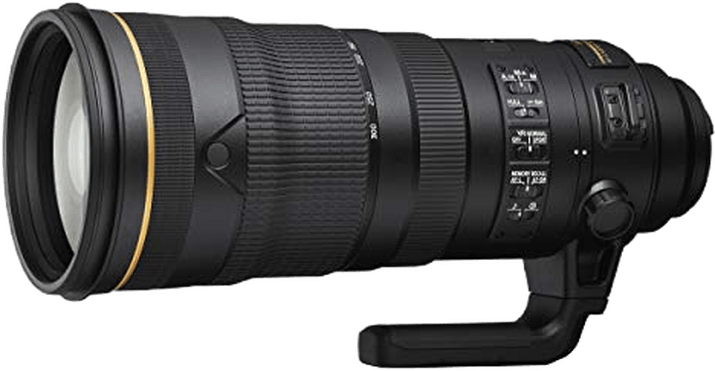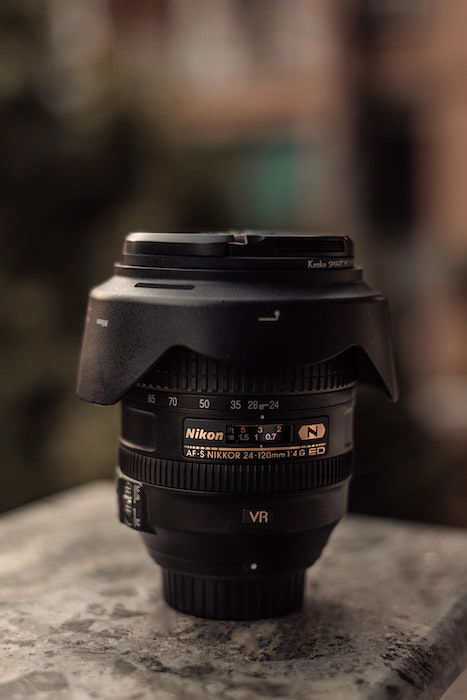To find out the properties of your Nikon lens, you can either check the lens manual or read the abbreviations around the lens. The sequence of letters you find may seem more like hieroglyphics than helpful pointers.
This article will look at a list of Nikon lens abbreviations. We will break them down so you will have a rough idea of what each set of letters means by the end. Don’t worry too much about memorising them, as you can always pop back to this list as a reference.

Lens abbreviations are a set of initials usually found after the lens focal point. You can find these abbreviations printed on your lens barrel. The initials will give you information about the properties and features of that specific lens.
These features include its autofocus drive, stabilization properties, and many others.
Let’s have a look at an example.
The Nikon AF-S NIKKOR 120-300MM F/2.8E FL ED SR VR.
As you can see from the lens’ name, there is information that you will probably be familiar with—the focal range and aperture number. A whole set of abbreviations are also in the title, however.
In this example, we come across AF-S, FL, ED, SR and VR. I can tell the lens can autofocus and has vibration reduction capabilities from this information. I can also tell there are extra-low dispersion and fluorite elements used in the lens and a lens element that refracts UV wavelengths.

Now you see that you can get crucial information from these abbreviations. Let’s take a deeper dive into the abbreviations you will encounter on your Nikon lens barrel.
A – A manual focus lens. Found on the original bayonet lens type from 1959. Considered pre-AI.
ADR – Aperture (A) direct (D) readout (R). This acronym came about as some Nikon lenses had an overhanging prism that covered the lens’ aperture numbers. This was implemented in AI lenses in 1977.
AF-I – An autofocus (AF) lens that has an integrated (I), core-less focus motor. AF-I lenses are D-type lenses. Still, some older film bodies cannot autofocus with them.
AF-P – A autofocus (AF) lens with special stepper motors. This autofocus feature came into effect in 2015. It requires a digital body with up-to-date firmware.
AF-S – A autofocus (AF) lens with a silent wave (S) integrated, core-less focus motor. It is the standard autofocus function for Nikon lenses.
AI – Automatic (A) maximum aperture indexing (I). This is the mechanical system for coupling the lens to the camera’s exposure system. This is for manual focus cameras and was implemented in 1977.
AI-P – A variant of the AI function. The lens has a built-in CPU that transfers metering data from the lens to the camera.
AI-S – Another variant of the AI function. It was designed to be used with shutter priority (S) exposure modes. This was for manual focus lenses.
ASP – This will have an aspherical lens (AS) element in its optical design. Aspherical lenses use complex curves in the creation of lens elements to get rid of lens aberrations and others.

C – A type of lens coating for pre-AI lenses. Nikon integrated coating.
CRC – Close (C) range (R) correction (C). This lens is designed to provide better focus at closer distances.
CX – Nikon 1 mirrorless camera lens. This was introduced to the market in 2011.
D – This will mean that the lens adds distance (D) information to the data transmitted to the camera body.
DC – A defocus (D) control (C) lens. This allows the photographer to change the degree of spherical aberration in out of focus areas. This will provide a better bokeh for the image.
DX – This is a common acronym that is for a lens that is designed for smaller-framed cameras. DX lenses are for DSLR’s but may work on some 35mm bodies.
E – Electronic (E) aperture activation. This will mean your lens does not have a physical connection to the aperture activation arm in the camera. Instead, it will use electric signals between camera and lens to control the aperture.
ED – Extra (E) low dispersion (D) elements are in this lens.
FL – Fluorite (FL) elements are in this lens. Fluorite elements are lighter weight than regular glass.
FX – A 35mm full frame sensor lens. This refers to the lens’ ability to cover the Nikon FX sensor.
G – This will be a lens without an aperture ring. You will need to control this in-camera.
HRI – High (H) refractive (R) index (I). One HRI lens can provide the same effect as several standard glass elements. This is specifically for field curvature and spherical aberrations.

IF – Lenses that use internal (I) focusing (F) rather than turning outer lens elements.
IX – A lens that is made for the Pronea system.
N – Nano (N) coating. This lens will feature a crystalline coating that gets rid of internal lens element refractions. This coating reduces ghosting and flare issues.
NIC – Nikon (N) integrated (I) coating (C). This lens will feature the Nikon glass coating system that helps with reducing flare and ghosting.
PC – A perspective (P) control (C) lens. This means you can shift the front of the lens to correct for perspective.
PF – Phase (P) fresnel (F). A type of diffraction optic that makes smaller lenses.
RF – Rear (R) focusing (F). This means that the lens focuses by moving its rear elements.
S-line – Superior (S) lens. Found on the Nikon mirrorless Z series.
SIC – Super (S) integrated (I) coating (C). Usually found on more complex zoom lenses, it is a lens coating that has multi-layer flare reduction capabilities.
SWM – This lens will have a silent (S) wave (W) motor (M). This type of motor is found in AF-I and AF-S lenses.
SR – Short-wavelength (S) refractive (R). This is a lens that has a particular lens element that refracts UV wavelengths. This is important because it reduces chromatic aberration.
UW – Underwater (UW) lenses for the Nikonos system.
VR – This means the lens will have vibration (V) reduction (R) capabilities. This corrects camera movement while taking the picture to reduce motion blur and camera shake.
Z – Lenses for Nikons mirrorless Z range.

From this list, we can see the usefulness of knowing these Nikon lens abbreviations. Every piece of technology that Nikon develops in their lenses will most likely be made into an acronym and displayed on the lens barrel. It is a great way to show off its features and adds prestige to the lens, almost like a war veteran displaying their accolades.
Now you know what everything means, go through your lenses to find their qualities. Who knows, maybe there is a feature that leads you to experiment with a new photography style.
If you’re a beginner trying to figure out these abbreviations, take our Photography for Beginners course to help you figure out everything else about photography!
